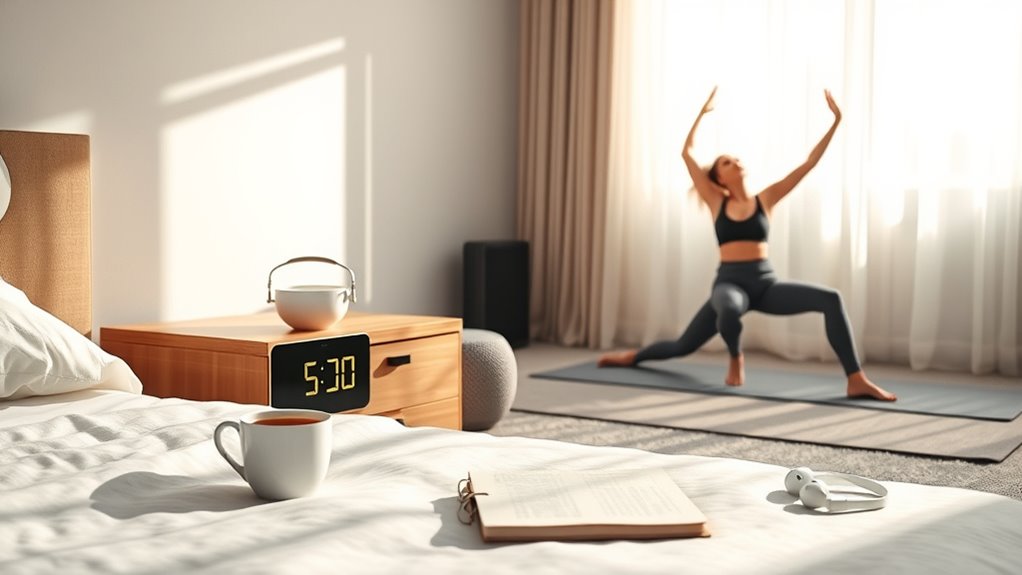Habit Building
Evening Rituals: How Nighttime Habits Improve Sleep and Well‑Being
Understanding and implementing effective evening rituals can transform your sleep quality and overall well-being, leaving you eager to discover how to create the perfect nightly routine.

Establishing calming evening rituals helps you shift smoothly into restful sleep and boosts overall well-being. By creating a consistent routine—such as dimming lights, relaxing activities, and maintaining a comfortable sleep environment—you signal your body to unwind and reduce stress. Avoiding screens and intense exercise before bed also improves sleep quality. These habits make falling asleep easier and enhance your health over time. Keep exploring ways to perfect your evening routine for better rest and greater energy.
Key Takeaways
- Establishing calming evening routines signals the body to relax, reducing stress and promoting better sleep quality.
- Consistent sleep schedules and habits help regulate the internal clock for easier, more restful sleep.
- Creating a sleep-friendly environment—cool, dark, quiet—enhances relaxation and minimizes disruptions.
- Pre-sleep activities like dimming lights and journaling reduce anxiety and prepare the mind for restful sleep.
- Using mindful habits and automation supports routine adherence, making healthy nighttime behaviors automatic.

Have you ever wondered how your evening routine can set the tone for a restful night? The way you wind down after a busy day plays a fundamental role in shaping your sleep quality and overall well-being. Establishing calming evening rituals helps you shift from the hustle of daytime activities to a state of relaxation, which is indispensable for good sleep hygiene. When you prioritize stress reduction during your evening, you signal to your body that it’s time to unwind, lowering cortisol levels and easing tension. This not only makes falling asleep easier but also improves the depth and restorative quality of your sleep. Engaging in relaxing activities like reading, gentle stretching, or listening to soothing music can help clear your mind of racing thoughts, reducing stress and promoting a peaceful mind before bed.
Creating a consistent routine is key to reinforcing healthy sleep habits. Going to bed and waking up at the same time every day helps regulate your internal clock, making it easier to fall asleep naturally and wake up refreshed. Avoiding stimulating activities close to bedtime, such as intense exercise or screen time, is essential. The blue light emitted by screens suppresses melatonin production, which interferes with your sleep hygiene. Instead, opt for calming rituals like dimming the lights, practicing deep breathing exercises, or journaling your thoughts to release worries. These practices foster a sense of control and calmness, further reducing stress and making your sleep environment more conducive to rest. Additionally, understanding how automation can play a role in optimizing your sleep routines—such as setting automated reminders for bedtime—can help reinforce these habits.
Consistent bedtime routines and relaxing activities promote restful, restorative sleep each night.
Your sleep environment itself should support your evening rituals. Keep your bedroom cool, dark, and quiet to optimize your sleep hygiene. Investing in a comfortable mattress and pillows can also considerably improve sleep quality. When your surroundings are inviting and free from distractions, your brain associates the space with relaxation, helping you drift off more easily. Additionally, cultivating a pre-sleep routine signals to your body that it’s time to wind down, reinforcing the connection between your habits and quality sleep. Over time, these habits become automatic, making it easier to transition into restful sleep night after night.
In short, your evening rituals can profoundly influence your sleep and overall well-being. By consciously incorporating stress reduction techniques and prioritizing sleep hygiene, you set the stage for a peaceful night’s rest. It’s about creating a gentle passage from the demands of the day to the tranquility of sleep, so your body and mind can fully recharge. The more consistent and mindful you are about your nighttime habits, the more naturally restful your sleep becomes, paving the way for better health and brighter days ahead.
Frequently Asked Questions
How Long Before Bed Should I Start My Evening Rituals?
You should start your evening rituals about 30 to 60 minutes before bed. This timing allows you to engage in relaxation techniques and wind down, promoting better sleep. Consistency is key, so try to stick to the same schedule each night. By establishing a routine within this window, you help signal to your body that it’s time to relax, making it easier to fall asleep and improve your overall well-being.
Can Evening Rituals Help With Insomnia or Sleep Disorders?
Evening rituals can be your guiding lighthouse through foggy nights, helping with insomnia and sleep disorders. By practicing good sleep hygiene and relaxation techniques, you calm your mind and prepare your body for restful sleep. Consistent routines signal your brain it’s time to wind down, easing you into slumber. These habits create a soothing rhythm, making it easier to overcome sleep struggles and embrace peaceful, restorative nights.
Are There Any Rituals I Should Avoid Before Bedtime?
You should avoid caffeine consumption and excessive screen time before bed. Caffeine can stay in your system and disrupt your sleep, so skip coffee or energy drinks at least six hours before bedtime. Also, limit screen time because the blue light from devices suppresses melatonin, making it harder to fall asleep. Instead, try relaxing activities like reading a book or practicing deep breathing to prepare your mind and body for restful sleep.
Do Different Age Groups Benefit From Specific Evening Routines?
An ounce of prevention is worth a pound of cure, so yes, different age groups benefit from specific routines. Teenagers need relaxation techniques to calm their minds before sleep, while seniors should establish a consistent bedtime to improve sleep quality. Tailoring your evening routine to your age helps optimize rest, so prioritize calming activities like reading or gentle stretches to support your unique sleep needs.
How Quickly Can I Expect to See Improvements in Sleep Quality?
You can start noticing improvements in your sleep quality within a week of adopting regular evening rituals. Incorporate relaxation techniques like deep breathing or meditation to help regulate your sleep cycle. Consistency is key, so stick to your routine every night. Over time, your body will adjust, leading to better sleep, fewer disruptions, and more restorative rest. Be patient, and you’ll see the benefits unfold gradually.
Conclusion
By embracing evening rituals, you naturally create a peaceful passage into sleep, often finding that these habits align just when you need them most. It’s almost as if your body and mind coordinate silently, whispering that rest is near. When you prioritize these habits, you might notice how even small changes seem to unexpectedly improve your well-being. Sometimes, it’s the simple coincidence of consistency and intention that open your best night’s sleep and brighter mornings.
Habit Building
Morning Routines 2025: Science‑Backed Practices for Starting the Day
Gaining insights into science-backed morning practices can transform your start to 2025—discover the routines that will elevate your day.

To start your morning in 2025, embrace science-backed practices like mindfulness meditation and hydration. Spend a few minutes focusing on your breath or calming thoughts to reduce stress and boost mental clarity, then drink a glass of water to rehydrate and kickstart your metabolism. These simple steps set a positive tone, improve focus, and energize you for the day ahead. Keep exploring to discover more effective routines that can transform your mornings into powerful beginnings.
Key Takeaways
- Incorporate 5-minute mindfulness meditation to improve mental clarity and emotional resilience.
- Hydrate immediately after waking to boost energy, metabolism, and toxin elimination.
- Combine mindful breathing with water intake to enhance focus and alertness.
- Establish a consistent routine to create lasting habits that set a productive tone for the day.
- Recognize immediate benefits like reduced stress and increased energy to sustain motivation long-term.

As mornings continue to evolve in 2025, your routine can set the tone for a productive day like never before. The key lies in adopting science-backed practices that boost your focus, energy, and overall well-being from the moment you wake up. One powerful way to do this is through mindfulness meditation. Starting your day with even just a few minutes of mindful breathing helps center your mind, reducing stress and sharpening your focus. This practice encourages you to become aware of your thoughts and sensations without judgment, which can lead to increased mental clarity throughout the day. Pairing mindfulness meditation with effective hydration strategies amplifies these benefits. When you hydrate first thing in the morning, you’re replenishing lost fluids after hours of sleep, which can improve cognitive function, mood, and energy levels. Drinking a glass of water shortly after waking up is a simple but impactful step that many overlook. It kickstarts your metabolism and helps flush out toxins, setting a clean slate for the day ahead.
Additionally, understanding retail hours for stores you might visit can help you plan your morning routines more efficiently, ensuring you can incorporate these practices without rushing or missing out. Incorporating these practices into your morning routine doesn’t require hours or elaborate setups. You can dedicate just five minutes to mindfulness meditation, focusing on your breath or a calming mantra, while simultaneously sipping on water or a hydrating beverage. This combo creates a ripple effect, enhancing alertness and emotional resilience. As your body awakens, your brain benefits from the increased oxygen and hydration, making it easier to tackle tasks with clarity. Over time, this routine can become a natural part of your day, helping you approach challenges with a calm and focused mindset.
Furthermore, integrating mindfulness meditation with hydration strategies can improve your consistency and motivation. When you recognize the immediate benefits—such as reduced morning anxiety and heightened alertness—you’re more likely to stick with these habits. The act of intentionally starting your day with purpose creates momentum, influencing how you manage stress and make decisions later on. As mornings continue to evolve, smartly combining mindfulness with hydration ensures you’re not just rushing through routines but embracing practices backed by science to optimize your mental and physical performance from the moment you wake up. This simple yet effective approach can transform your mornings into a foundation for a more mindful, energized, and productive day.
Frequently Asked Questions
How Long Should a Morning Routine Ideally Last?
A morning routine should ideally last around 20 to 30 minutes, but you can customize the duration based on your needs. Focus on routine consistency to build habits that boost your productivity and well-being. If you find longer routines overwhelming, start small and gradually extend them. The key is to make your routine sustainable and enjoyable, ensuring it fits seamlessly into your morning without adding stress.
Can a Flexible Routine Be as Effective as a Fixed One?
A flexible routine can be just as effective as a fixed one if you incorporate personalization strategies that suit your lifestyle. You should focus on consistency versus flexibility by allowing adaptable activities that keep you engaged without feeling rigid. This approach helps maintain motivation and reduces stress, ensuring your routine supports your well-being. Ultimately, tailoring your morning habits encourages sustainability and makes it easier to stick with your routine long-term.
What Are the Best Practices for Overcoming Morning Fatigue?
To overcome morning fatigue, prioritize good sleep quality by sticking to a consistent sleep schedule. Hydration strategies also help; drink a glass of water right after waking up to boost alertness. A study shows that proper hydration can improve energy levels by 14%. Avoid hitting snooze, and get moving quickly—light exercise or stretching can jumpstart your day. These habits help you feel more energized and ready to face the morning.
How Do Morning Routines Impact Long-Term Mental Health?
Your morning routines substantially impact your long-term mental health by fostering consistency and positive habits. Incorporating mindfulness meditation can reduce stress and improve emotional resilience, while journaling benefits include clarity and emotional release. When you start your day with these practices, you build a strong foundation for mental well-being, helping you manage daily challenges more effectively and cultivating a healthier mindset over time.
Are There Specific Routines Suitable for Night Owls Versus Early Birds?
Yes, night owl habits benefit from late-night routines like relaxing activities, while early bird strategies include morning sunlight and exercise. You should tailor your routine to match your natural rhythm, incorporating calming practices if you’re a night owl and energizing ones if you’re an early bird. By aligning your habits with your chronotype, you improve sleep quality and overall well-being, making it easier to start each day positively.
Conclusion
By adopting science-backed morning routines, you set a positive tone for your entire day. Did you know that people who meditate in the morning report 40% higher productivity? Incorporating just a few of these practices can boost your focus, mood, and energy levels. Start tomorrow with intentional habits, and you’ll notice how small changes lead to big improvements over time. Your best day begins with how you start it.
Habit Building
Tracking Habits With Wearables: Using Data to Strengthen Routines
Tracking habits with wearables reveals insights that can transform routines, but understanding how to harness this data is essential for lasting change.

Using wearables to track your habits provides you with precise data on your daily routines, helping you see patterns and identify areas for improvement. These devices make monitoring health metrics and activity levels convenient, so you can reinforce positive habits and adjust those that aren’t working. Compatibility and data privacy are important, so choose vetted devices that suit your smartphone. Keep exploring to discover how to harness this data effectively for long-term routine success.
Key Takeaways
- Wearables enable continuous activity and health metric tracking to identify habits and monitor progress over time.
- Data collected helps analyze patterns, allowing for targeted habit adjustments and routine optimization.
- Ensuring device compatibility with your smartphone guarantees seamless syncing and accurate data collection.
- Selecting vetted, reliable wearables protects data privacy and ensures trustworthy habit tracking performance.
- Proper use of wearable data supports consistent habit reinforcement and long-term routine strengthening.
Many people are turning to wearables to better understand and improve their habits. These devices offer a convenient way to track activities, monitor health metrics, and gather data that can help you refine your routines. But as you start relying more on wearables, it’s essential to consider factors like data privacy and device compatibility. Your personal information is valuable, and understanding how your data is stored and shared should be a priority. Manufacturers often have different policies on data privacy, so it’s wise to read the privacy policies carefully. Some devices store data locally, while others upload it to cloud servers, which could pose risks if security measures aren’t robust. Knowing how your data is protected can help you make informed decisions about which wearable to use and how much information you’re comfortable sharing. Additionally, considering vetted products that have undergone safety and effectiveness reviews can help ensure you select a device that meets high standards. Device compatibility is another vital aspect. Not all wearables work seamlessly with every smartphone or operating system. Before purchasing, check whether the device is compatible with your phone or tablet. Some wearables are designed specifically for iOS, while others work better with Android. Compatibility issues can lead to frustration, such as syncing problems or limited functionality, diminishing the benefits you expect from tracking your habits. Ensuring your wearable integrates smoothly with your existing devices guarantees you get real-time updates and thorough data collection, which are essential for analyzing your routines effectively.
Frequently Asked Questions
How Accurate Are Wearable Devices in Tracking Specific Habits?
Wearable devices are generally quite accurate for tracking specific habits, but their precision depends on factors like sensor calibration and data synchronization. When sensors are well-calibrated, they provide reliable data, helping you understand your habits better. However, if data isn’t synchronized properly across devices or apps, it can lead to inaccuracies. To get the best results, regularly update your device’s firmware and guarantee proper sensor calibration.
Can Wearables Help Modify or Break Bad Habits Effectively?
Think of wearables as your personal cheerleader in your journey to break bad habits. They can effectively support behavior change and habit reinforcement by providing real-time feedback and reminders. When you track patterns, you spot triggers and celebrate small wins, making it easier to replace bad habits with healthier ones. While not a magic wand, they’re a powerful tool to help you stay committed and make lasting changes.
What Features Should I Look for in a Habit-Tracking Wearable?
When choosing a habit-tracking wearable, look for motivational features like reminders, badges, or streaks to keep you engaged. Customization options are also key—ensure it allows you to tailor goals and notifications to fit your routine. A device with real-time feedback, easy data syncing, and a user-friendly app helps you stay accountable and motivated. Prioritize these features to make habit tracking both effective and enjoyable.
How Does Data Privacy Work With Wearable Habit Trackers?
Did you know that 78% of users worry about their data privacy? Your wearable habit tracker protects your info through data encryption, making it unreadable to outsiders. Plus, your device only shares data with your consent, ensuring you’re in control. Always review privacy settings and understand the app’s policies—this way, your routines stay private, and your data remains secure.
Are There Any Recommended Apps to Supplement Wearable Habit Tracking?
You should try apps like Strava, Fitbit, or MyFitnessPal, which supplement your wearable habit tracker. They often include fitness challenges to keep you motivated and enable social sharing, so you can connect with friends and stay accountable. These apps sync seamlessly with your devices, offering detailed insights into your progress and helping you build consistent routines while keeping your data secure.
Conclusion
By embracing wearables, you gently guide your routines with subtle insights, allowing habits to evolve naturally over time. The data becomes a quiet partner, offering hints rather than commands, helping you refine your daily rhythm without overwhelming. With patience and awareness, you’ll find yourself steadily aligning your actions with your intentions, all while maintaining a sense of effortless grace. Ultimately, these tools serve as a refined compass, steering you toward a more harmonious and mindful lifestyle.
Habit Building
Reward Systems & the Premack Principle: Motivating New Habits
I’m here to show you how the Premack Principle can transform your motivation, but the key lies in understanding the subtle ways rewards work.

You can boost your habit formation by using the Premack Principle, which pairs less preferred tasks with activities you enjoy. For example, reward your workout with listening to favorite music or a special treat afterward. This approach creates natural incentives and makes routines more appealing, increasing your motivation to stick with them long-term. Keep exploring how to combine activities effectively, and you’ll discover even more ways to make habits easier to build.
Key Takeaways
- The Premack Principle uses preferred activities as rewards to reinforce less desirable behaviors, boosting motivation for habit formation.
- Pairing enjoyable activities with routine tasks creates positive associations, making habits more sustainable over time.
- Incorporating small rewards like music or social breaks leverages intrinsic motivation, encouraging consistent behavior change.
- Selecting rewards aligned with personal preferences enhances effectiveness and helps embed new habits naturally.
- Strategic use of reward systems fosters long-term motivation, reducing effort needed to maintain habits and promoting lasting change.

Reward systems are essential tools for shaping behavior, and the Premack Principle offers a simple yet powerful way to understand how they work. When you’re trying to develop new habits, leveraging this principle can considerably boost your motivation strategies and make habit formation more effective. Essentially, the Premack Principle states that more preferred activities can serve as rewards for less preferred ones. This means that if you enjoy a particular activity, you can use it to motivate yourself to complete tasks you find less appealing, creating a natural incentive for behavior change.
Reward systems use preferred activities as incentives to motivate less appealing tasks.
Imagine you want to establish a daily exercise routine. Instead of viewing workouts as a chore, you can pair them with something you genuinely enjoy, like listening to your favorite music afterward. Once you’ve completed your workout, you reward yourself with that preferred activity, reinforcing the habit through positive association. Over time, this pairing strengthens your motivation to stick with the routine, making habit formation smoother and more sustainable. The key is to identify your motivation strategies—what activities you value most—and use those as incentives to promote desired behaviors.
This approach taps into your intrinsic motivation, making the process of forming new habits feel less like a chore and more like a series of rewarding experiences. For example, if you’re trying to read more, you might allow yourself a small treat after finishing a chapter—like a cup of coffee or a short break to browse social media. As you consistently associate the less appealing activity (reading) with a rewarding one, your brain begins to see the habit as something worthwhile, increasing your likelihood of maintaining it over the long term. Additionally, using motivational strategies that are aligned with your preferences can enhance the effectiveness of this approach.
Using the Premack Principle for habit formation isn’t just about immediate rewards; it’s about creating a sustainable cycle of motivation. The more you reinforce positive behaviors with activities you enjoy, the more ingrained they become in your routine. Over time, these habits require less conscious effort because they’re linked with pleasurable experiences, turning initially challenging tasks into routine parts of your day. The secret lies in carefully selecting your motivation strategies—those activities that genuinely bring you joy—and using them as leverage to develop new, lasting habits.
Frequently Asked Questions
How Do Reward Systems Influence Long-Term Behavior Change?
Reward systems influence your long-term behavior change by strengthening habit formation and fostering intrinsic motivation. When you reward yourself for small wins, you create positive associations that encourage consistency. Over time, these rewards help develop habits that become ingrained, reducing reliance on external motivators. By gradually shifting focus to intrinsic motivation, you’re more likely to maintain new behaviors naturally, making lasting change easier and more sustainable.
Can the Premack Principle Be Applied to Children With Special Needs?
Think of the Premack Principle as a bridge connecting your child’s interests to desired behaviors. You can absolutely apply it to children with special needs through individualized strategies and adaptive techniques. By tailoring rewards based on their preferences and abilities, you turn motivation into a powerful tool, helping them build new habits step by step. This personalized approach transforms challenges into opportunities for growth and success.
What Are Common Mistakes When Implementing Reward Systems?
You might over-reward behaviors or apply rewards inconsistently, which can undermine their effectiveness. Avoid giving rewards too frequently or for minor actions, as this can reduce motivation over time. Make certain you apply reward systems consistently so your child understands expectations. By focusing on meaningful reinforcement and maintaining consistency, you help foster genuine habit formation and avoid common mistakes that hinder progress.
How Does Intrinsic Motivation Interact With Extrinsic Rewards?
Research shows that intrinsic motivation often diminishes when extrinsic rewards are introduced, highlighting a complex interaction in motivation dynamics. When you rely solely on extrinsic rewards, you risk overshadowing your internal drive for the activity, which may weaken long-term commitment. Instead, balancing intrinsic motivation with appropriate extrinsic rewards can enhance overall motivation, fostering sustainable habits. Recognizing this interaction helps you design effective strategies that sustain your engagement over time.
Are There Cultural Differences in the Effectiveness of Reward Systems?
Yes, there are cultural differences in how effective reward systems are. You might notice that in some cultures, reward perception aligns with cultural norms, making rewards more motivating, while in others, extrinsic rewards may be less effective or even counterproductive. Your approach should consider local values and practices, tailoring reward systems to fit the cultural context for better motivation and habit formation.
Conclusion
By understanding how reward systems and the Premack principle work together, you can effectively motivate yourself to build new habits. It’s like turning your favorite activities into rewards for less enjoyable tasks, making progress feel more natural. Some argue this approach is just a clever trick, but countless success stories show it genuinely helps change behavior. So, give it a try—your motivation might just skyrocket when you pair effort with the activities you love most.
-

 Wish Notes1 year ago
Wish Notes1 year agoBest Caption to Wish Myself a Happy Birthday That Everyone Will Like!
-

 Wish Notes1 year ago
Wish Notes1 year agoThe Best Birthday Wishes to Make Your Uncle's Day Bright!
-

 Wish Notes1 year ago
Wish Notes1 year agoThe Sweetest Happy Birthday Wishes for Your Wife!
-

 Wish Notes1 year ago
Wish Notes1 year agoThe Best Happy Birthday Wish for Your Brother That Will Make Him Smile!
-

 Wish Notes1 year ago
Wish Notes1 year agoHeartwarming Birthday Messages for Mom in Spanish
-

 Wish Notes1 year ago
Wish Notes1 year agoThe Best Happy Birthday Wishes for Your Husband That Will Make His Day!
-

 Wish Notes1 year ago
Wish Notes1 year agoThe Ultimate Birthday Wishes to Celebrate Yourself!
-

 Wish Notes1 year ago
Wish Notes1 year agoThe Most Heartfelt Good Night Wishes Ever!













